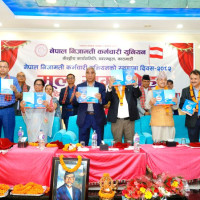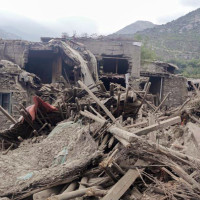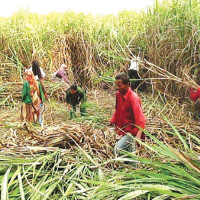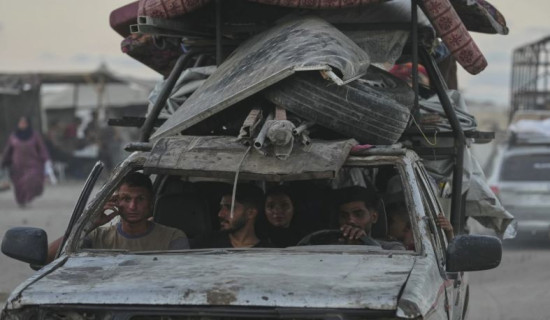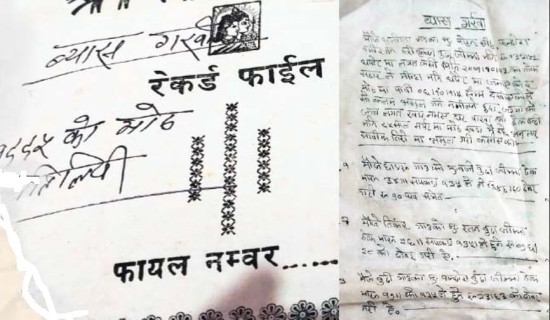- Friday, 5 September 2025
Rakhi making headway among hilly communities
By Arpana Adhikari,Kathmandu, Aug. 10: On Janai Purnima day, while men across the country wear the new Janai (sacred thread) and families relish steaming bowls of Kwanti, mixed sprouted beans, the air is filled not only with festive aromas but also with a quietly growing thread of cultural unity.
Alongside these age-old sacred rituals, the vibrant tradition of Rakhi, once predominately rooted in the Tarai Madhes, where sisters tie colourful threads on their brother’s wrists as a symbol of love and protection, is being embraced by communities in Nepal’s hilly regions. Ashesh Upadhyay, a 40-year-old banker from Bishalnagar, shared that Rakhi has always been a part of his family’s life.
“For as long as I can remember, we’ve celebrated this beautiful bond between siblings,” he said. When asked if celebrating Rakhi is unusual in his community, he smiles, “How could anyone question a celebration of such a pure bond?”
His father, Hari Upadhyay, recalls how he introduced the tradition of Rakhi to their family nearly four decades ago. “In 1986, after the birth of my second child, a son, I felt inspired to mark the occasion alongside my elder daughter,” he said.
“The thought struck me that this celebration would bring joy among my children,” he recalled. “Any festival that spreads happiness is worth embracing. Rakhi is a beautiful bond between siblings, and as Hindus, we can cherish it wholeheartedly,” he added.
For Sujata Karki, a Bachelor’s student from Lokanthali, the festival entered her life 15 years ago through her Madhesi tenants. “Seeing them celebrate it with such colour and joy drew me into the culture,” she recalled.
Initially, she had to convince her mother, who was reluctant to buy her a Rakhi for her brother. “My mother eventually agreed, and since then, we have cherished the tradition.”
Resha Gurung, seen buying Raksha Bandhan at a shop in Balkot on Saturday morning, shared that she and her cousins have been celebrating the festival for the last three years.
A 12th-grade student recalled how TikTok and Bollywood movies, filled with Rakhi contents, inspired her to celebrate the festival. She claimed that some of her relatives and friends, also take part in the celebrations.
Gurung, Karki and Upadhyay represent many in Nepal’s hills who now observe the festival.
A quick glance through social media platforms like TikTok and Facebook reveals numerous people from hill regions sharing their Raksha Bandhan celebrations, signaling the festival’s growing popularity beyond its Tarai origins.
This rise in demand is clear in Kathmandu Valley’s markets, where shops at every corner are now stocked with a wide variety of Rakhis, items once found mainly in Tarai markets.
Rekha Sharma, a cosmetic shop owner in Chardobato, Bhaktapur has been selling Rakhis for five years. “This year, I sold around 200 Rakhis priced between Rs. 50 and 80,” she said.
The tradition is also flourishing in schools across Kathmandu Valley, where children exchange Rakhis regardless of caste or ethnicity, nurturing a new generation familiar with the customs.
Ranju Yadav, a Mithila artist originally from Dhanusa now living in Kathmandu, expressed her joy at seeing Madhesi traditions like Raksha Bandhan and Chhath being embraced by hill communities.
“It is a beautiful celebration of the bond between siblings and a meaningful day of reunions,” she said.
Experts note that internal migration, mixed marriages, urbanisation and the influence of social media and Bollywood movies and serials have all contributed to the blending of cultural traditions.
Tarai-origin families living in hill cities like Kathmandu and Pokhara are increasingly sharing their customs, fostering mutual respect and appreciation.
Culture expert Prof. Dr. Ram Chandra Gautam said that migration and cross-cultural exchange often carry traditions from one region to another, such as Gaura from western Nepal, and Chhath and Rakhi from the Madhes.
He explained that during Janai Purnima, the tying of Raksha Bandhan (a sacred thread known as doro), when performed with proper Vedic rituals and mantras, holds deep scriptural significance, as it is believed to bring happiness, peace, and protection.




